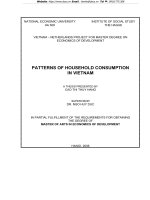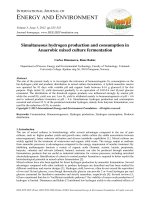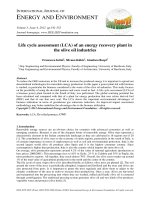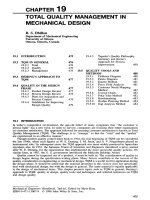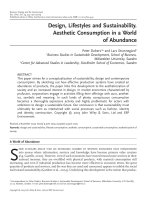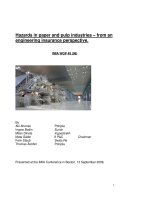Total polymer consumption in automobile sector in pune region appl industries pune by mrinal khajuria marketing
Bạn đang xem bản rút gọn của tài liệu. Xem và tải ngay bản đầy đủ của tài liệu tại đây (254.16 KB, 57 trang )
1
A
Project Report
On
Total Consumption Of Polymer In Automobile Sector In Pune
Region
With Special Reference To
APPL. Industries Limited, Pune
Submitted To
Vishwakarma Institute Of Management, Pune
In Partial Fulfillment Of The Requirement
For The Aw
ard Of Degree Of
Master Of Business Administration
By
Mrinal Khajuria
(2004
-
06)
Under The Guidance Of
Mr. Yuvraj Lahoti
(Professor, VIM)
2
CERTIFICATE OF SUMMER TRAINING COMPLETION
This is to certify that Project Report titled Total Consumpti
on
Of Polymer in Automobile
Sector In Pune Region
has been completed satisfactorily in partial fulfillment of Master Of
Business Administration course for the academic year 2004-2006 by Mrinal Khajuria, Student of
Vishwakarma
institute of management
pu
ne
-
37
.
Place: Pune
D
irector,
Date:
Vim, pune
-
37
3
GUIDE CERTIFICATE
This is to certify that Mr. Mrinal Khajuria student of Master of business administration course
with specialization in Marketing, for the session August 2004- July 2006 prepared project report
entitled
Total Consumption Of Polymer in Automobile Sector In Pune Region
at
Aalekh
polymers PVT. Limited
. From15
th
June to 30
th
July under my guidance and supervision.
I wish him all success in life.
Prof. Yuvraj lahoti
(Marketing)
4
5
TABLE OF CONTENTS
S.No
TOPIC
PAGE No.
1.
INTRODUCTION
10
-
11
2.
COMPANY PROFILE
13
-
14
3.
PRODUCT PROFILE
16
-
20
4.
OBJECTIVES OF THE STUDY
22
5.
RESEARCH METHODOLOGY
24
6.
OBSERVATIONS AND FINDINGS
26
-
45
7.
CONCLUSIONS & SUGGESTIONS
47
-
49
8.
ANNEXURES
51
-56
6
ACKNOWLEDGEMENT
I take the occasion to thank Aalekh polymers private Limited
for giving me the opportunity to
work on this project, which has immensely helped in gaining & developing my knowledge &
experience. I would like to thank my institute VIM as well as Director sir Dr. Sharad L Joshi to
provide me such a wonderful opportunit
y.
I especially thank my project guide Mr.Yuvraj Lahoti (professor, VIM) for his valuable guidance,
co
-
operation & encouragement throughout the project.
I am also Grateful to Mr.Arun Sharma (senior head marketing) and Mr.Inder Jain (CEO
)
for
providing their valuable thoughts and inputs throughout the project & kindly accepting the
suggestions & recommendations given by me.
I am very thankful to god as well as my family who really helped me during the project work
without there ally and support it its not po
ssible to study here in a very pleasant atmosphere.
Lastly I would like to specially thank the subordinates & their superiors for their co-operation and
also would like to thank to all the respondents of the survey, members of the faculty & all my
other fe
llow summer trainees for their co
-
operation & co
-
ordination in the project along with me.
Place
-
Pune
Mrinal Khajuria
7
EXECUTIVE SUMMARY
Objectives:
-
1)
To know
the total polymer consumption in the automobile sector
2)
How many injection moulding companies are using polymers for automobile industry in Pune
Region?
3)
What are the prices at which injection moulding companies are buying raw materials from
other manufacturers
4)
To know the availability of substitutes and grade of polymers in Pune region
5)
To find out
the awareness of the product in the market
6)
To know the strengths and weaknesses of the companies
7)
To know various parameters whatever the business rivals of APPl. are following:
o
Marketing strategy
o
Pricing policy
o
Credit policies
Findings:
-
Polypropylene
is used readily in automobile sector because we can enhance its properties by
adding filler for example: glass, mica, talc, etc. as per the requirement of the product. Appl
produces PP + Filler as per the customer requirements. Polypropylene is used in b
umpers,
dashboards, fuel tanks etc. Polypropylene is used frequently because:
1)
There is no problem in the availability.
2)
Its trends do not vary.
3)
It is cheaper then metal.
4)
Properties are more or less same as of metals.
5)
The weight is lesser then metals
which helps in increasing average of the vehicle.
8
Recommendations:
-
The company should increase sales
The company should try to reduce the cost of production
Growth opportunities in public transport and commercial sectors
Material handling
Sourcing of
materials
Proper inputs from customer
Trend analysis
Limitation of the study:
-
Sometimes consumers are not aware of the new product
Due to limited sample representation population may not be that much accurate
I, here by declare that this project report entitle Total polymer Consumption In Automobile
Sector
with special reference to APPL Industries Limited Pune, Which is the outcome of the
summer training undergone by me from 15
th
June 2005 to 30
th
July 2005
.
The empirical finding
of the study is ent
irely based on the data collected by myself.
9
10
INTRODUCTION
History and significance of polymers
Plastics are polymers. What is a polymer? The simplest definition of a polymer is something
made of many units. Think of a polymer as a chain. Each link of the chain is the "mer" or basic
unit that is made of carbon, hydrogen, oxygen, and/or silicon. To make the chain, many links or
"mers" are hooked or polymerized together. Polymerization can be demonstrated by linking strips
of construct
ion paper together to make paper garlands or hooking together hundreds of paper clips
to form chains.
Polymers have been with us since the beginning of time. Natural polymers include such things as
tar and shellac, tortoise shell and horns, as well as tree saps that produce amber and latex. These
polymers were processed with heat and pressure into useful articles like hair ornaments and
jewelry. Natural polymers began to be chemically modified during the 1800s to produce many
materials. The most famous of these were vulcanized rubber, gun cotton, and celluloid. The first
synthetic polymer produced was Bakelite in 1909 and was soon followed by the first semi-
synthetic fiber, rayon, which was developed in 1911
Even with these developments, it was not until World War II that significant changes took place
in the polymer industry. Prior to World War II, natural substances were generally available;
therefore, synthetics that were being developed were not a necessity. Once the world went to war,
our natural sources of latex, wool, silk, and other materials were cut off, making the use of
synthetics critical. During this time period, we saw the use of nylon, acrylic, neoprene, SBR,
polyethylene, and many more polymers take the place of natural materials that were no longer
available. Since then, the polymer industry has continued to grow and has evolved into one of the
fastest growing industries in the U.S. and in the world.
Characteristics of Polymers
The two major groups of polymers are thermoplastics and thermosets. Thermoplastic and
thermosetting nature is based on the heat response of polymers. The light transmittance of
polymers includes the description of materials as being transparent, translucent, or opaque.
Transparent polymers are those that you can see thr
ough, translucent are those that you cannot see
through but allow light to pass through, and opaque polymers are those that you can neither see
through nor allow light to pass through. Light penetration qualities are dependent on the degree of
crystallizat
ion of the polymer and the presence of additives.
11
Every polymer has very distinct characteristics but most polymers have the following general
attributes.
1. Polymers can be very resistant to chemicals
2. Polymers can be both thermal and electrical insul
ators
3. Generally, polymers are very light in mass with varying degrees of strength
4. Polymers can be processed in various ways to produce thin fibers or very intricate parts
As a leading manufacturer of engineered thermoplastic compounds having largest capacity in
India with multilocational compounding base, thus providing the complete solutions for
Automotive and Appliances Industries.
Research and Development
Manufacturing is fully supported by a team of dedicated Research and Development officers. A
laboratory scale Extruder very similar to the production machines has been installed in our R & D
department. This ensures that the scale up is smooth from R&D to production. In house R&D also
helps us to develop new materials in the shortest time period to meet our customer's new and
exacting requirements. R & D department is well dedicated to upgrade our material time to time
as per customer's requirements.
12
13
Company Profile
About APPL
APPL
Industries Limited, which has been formed by the merger of three groups of companies
Aalekh Polymers (P) Limited, Aalekh Industries (P) Ltd., and Prateek Enterprises, is one of the
leading compounder of engineered thermoplastics in India. We have been providing material
solutions to our customer for over 15 years. Today, we offer precoloured compounds based on
Polyolefin s and engineering plastics modified with minerals, glass fiber/beads, wood flour, flame
retardants etc. We also offer blends and alloys of various plastics, colour concentrates and
additive master batches.
Article I.
APPL Facilities
Production units at multiple sites
-
strategically located to meet customer's requirements.
Latest fully Computer controlled state-
of
-
the
-art compounding systems from Germany, Japan
offer Advanced
Materials Technologies.
International standard Quality Control Laboratory.
APPL
has established highly sophisticated Polymer Compounding units at IMT Manesar near
Delhi and at Pune in Maharashtra with a total installed capacity of 30,000 MTA, and by the
end of
2006, APPL will set up its third compounding unit at Hosur, Tamil Nadu with additional 10,000
MTA capacities.
APPL PROCESS
Twin Screw Super Compounders
Co
-
rotating and counter
-
rotating type
Gravimetric Loss
-
in
-
Weight feeders from Brabender Techn
ologies, K
-
Tron
Automation of material handling
Our production equipment and its variety allow us to match each product to the right process,
highest and consistent product quality in shortest lead
-
time.
VISION
To be a multilocation company engaged in production of Engineered Thermoplastic Compounds
based on Polyolefin s and Engineering Plastics, thereby attaining a top-performing compounding
industry dealing in multiple products and developing new applications close to customers
.
14
MISSION
To provide materials based on advanced technology to our esteemed customers, which meet
challenging demands.
To respect the strength and capability of all our employees, customers and associates. To
honour all commitments we undertake.
ACHIEVEMENTS
1990:
-
The Company
was established at New Delhi to manufacture Color Concentrate.
1995:
-
Manufacturing Plant dedicated for Black Masterbatch was set up at Rajasthan.
1998
: -
Two compounding line from Japan were installed at Delhi for PPAM compounds.
2001:
- Two state-
of
-
the
-art compounding line from Theysohn Maschinenbau, Germany were
installed at pune.
2002:
- Commissioned IMT - Manesar plant with two lines from Japan and two more
Compounding Lines from Theysohn, Germany.
2003:
-
Obtained ISO
-
9001:2000 accreditation.
20
03:
-
Automated
Feeding system was installed at IMT
Manesar Plant.
2004
: - Appointed as consignment agent of Ciba Speciality chemicals for plastics additives for
Eastern India.
2005:
-
Accelerated Weather meter instrument was set up at Pune plant.
2005
:
- Two state-
of
-
the
-art compounding lines from Coperion were installed at Pune and IMT
Manesar plant.
2005:
- Two Research & Development purpose compounding lines from Coperion were installed
at Pune and IMT Manesar plant.
2006
: -
One Counter Rotating Tw
in screw extruder from Japan was installed at Pune
15
16
SEGMENT
DESCRIPTION
TRADE NAME
Advanced Poly
propylene
Compounds
APPCOM
Advanced Styrenic
Compounds
APPSTRON
Advanced Colour
Masterbat
ches
APPCOL
Engineered Plastics based on
Commodity Resins
Speciality Additive
Masterbatches
APPLENE
Polycarbonate Compounds
APPNATE
Alloys
APPLOY
PBT Compounds
APPET
Engineered Plastics based on
Advanced Plastic Resins
Nylon Compounds
APPLON
17
Engineered Plastics based on Commodity Resins
A product may start with homopolymer, copolymer, TPO (rubber-modified alloys). The
application may require UL recognition, special stabilizers for improved weatherability, and extra
heat stabilizers for under the hood applications. The type, particle size and amount of filler can be
adjusted as per requirement for their aesthetics and mechanicals. For improved impact, impact
modifier can be incorporated. We can provide pre-colored materials as well as natural colour
materials. A complete product listing, incorporating all would be too long to list.
Our ABS and HIPS compounds have been developed specifically to meet the requirements of
major customers. These grades are the cost-effective answer for purchasers. These grades are
available as per customer-specific colours. Our ABS compounds offer excellent processability,
good heat resistance and show good balance between impact resistance and rigidity.
APPL
also offer SAN compounds, which have high heat resistance and chemical resistance. It
has a wide range of applications in electrical/electronic parts, automotive parts, office
consumables and so on.
18
An engineer
ed plastic based on commodity resins includes:
-
ADVANCED POLYPROPYLENE COMPOUNDS: These compounds are used in
manufacturing bumpers, instrumental panel, door trims, speedometer housing,
speedometer body cover, seat side balance, household items, case hea
ter of air conditioner,
automotive filters, refrigerator body parts, foot rest paddles etc.
ADVANCED COLOUR MASTERBATCH GRADES: These resins are used in
manufacturing Cover Inner of Two Wheeler Sector, Washing Machine Body Part, Tray
for Washing Machin
es, Hood Meter Cluster.
ADVANCED ADDITIVE MASTERBATCH GRADES: These resins are used in
manufacturing
Blown Film.
ADVANCED STYRENIC COMPOUNDS: These resins are used in manufacturing
Washing Machine Body Parts, Hood Meter Cluster, UPS Body Parts, Blower for Air-
Conditioner,
Two Wheeler Front Cover, Seat and Door Handle, UPS Housing.
19
Engineered Plastics based on Advanced Plastic Resins
We at
APPL
are offering various grades of mineral filled, glass reinforced, fire retardant
polycarbonat
e compounds, and their alloys, compounds of PBT and nylon. Our R & D
department is constantly working in this wide spread Engineering Plastics field.
Polycarbonate and its alloys e.g. PC/ABS, PC/PBT, PS/ASA characterized by their unique
balance of impact strength, heat resistance and high mechanical properties are the right choice
for a multitude of applications including automobile, medical equipment, optical, electrical
and electronics, home appliances and various other sectors.
Polybutylene Terephthalate (PBT) resin with its combination of heat, chemical resistance,
and outstanding electrical properties deliver unique design advantages with exceptionally
good processability & surface appearance. PBT compounds find application in
electrical/electronic connectors, automotive components, telecommunication enclosures & so
on.
Nylon is the most versatile plastics-easy to process; easy to modify to meet specific needs,
environmentally responsible in production. Due to their outstanding properties these material
s
have become indispensable in almost all fields of engineering for the wide variety of
components and machine parts, as high-quality electrical insulating materials and for many
special applications.
Nylon grades are exceptional for their high mecha
nical strength, rigidity & thermal stability.
20
Engineered Plastics based on Advanced Plastic Resins includes:
-
POLYCARBONATE COMPOUNDS
:
These resins are used in manufacturing
Head
Lamp Reflector, Door Handle,
Electrical/Electronic Body Parts.
AL
LOYS:
These resins are used in manufacturing Wheel Cover, Inverter Housing, Cub
Panel & Exterior Automotive Body Parts, Exterior Automotive Body Parts, Tail Light
Housing.
PBT COMPOUNDS: These resins are used in manufacturing Garnish, Louvers,
CFL
Housin
g
NYLON COMPOUNDS: These resins are used in manufacturing Chain Cover, Heater
Cover,
Handle Window Regulator,
Roof Clip, Radiator Fan, Handle, Ash Tray
21
22
OBJECTIVES OF THE STUDY
1.
To know
the total polymer consumption in the
automobile sector
2.
How many injection moulding companies are using polymers for automobile industry in Pune
Region?
3.
What are the prices at which injection moulding companies are buying raw materials from
other manufacturers
4.
To know the availability of su
bstitutes and grade of polymers in Pune region
5.
To find out the awareness of the product in the market
6.
To know the strengths and weaknesses of the companies
One more important aspect is transportation related issues:
-
incidents like chemicals get
contam
inated during transportation process due to:
-
o
Delays in transporting
o
Exposure to air
o
Leakages in tanks
To know various parameters whatever the business rivals of APPl. are following:
o
Marketing strategy
o
Pricing policy
o
Credit policies
23
24
Research Methodology
RESEARCH APPROACH
1)
Observation and survey
a)
In this research report survey method is used. Survey is the method of gathering of
primary data by asking the questions to the customers about their usage and requirements.
2)
Contact method
a)
Telephone
b)
Personal interviews
c)
E-
mails
3)
Target respondents
Here personal interviews of all the respondents are taken; Proprietors of all injection moulding
companies are interviewed personally at their specific place where they are standing
RESEARCH
DESIGN
The research has been done for the market of polymer consumption in automobile sector so the
research design for this survey is exploratory research
For the presentation and preparation of this report I have covered following things:
-
1)
Study of th
eory
2)
Market research
3)
Sample questionnaire
4)
Graphical presentation
5)
Analysis of data
6)
Company visit
7)
Internet information, books, magazines
25
